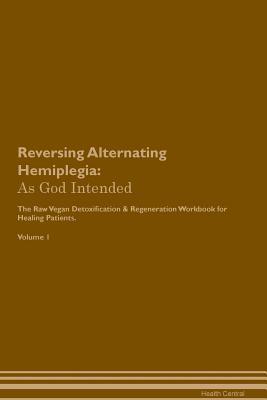Read Reversing Alternating Hemiplegia: As God Intended The Raw Vegan Plant-Based Detoxification & Regeneration Workbook for Healing Patients. Volume 1 - Health Central | ePub
Related searches:
Alternating hemiplegia of childhood is a severe neurological disorder with infantile-onset recurrent episodes of hemiplegia on either side of the body and other paroxysmal events such as seizures, dystonia, tonic episodes, abnormal eye movements or autonomic dysfunction, primarily due to de novo pathogenic mutations in the atp1a3 gene.
Alternating hemiplegia of childhood (ahc) is an ultra-rare neurodevelopmental disease. The prevalence is 1 in a million, and it was first reported in the medical.
Weber's syndrome, also known as midbrain stroke syndrome or superior alternating hemiplegia, is a form of stroke that affects the medial portion of the midbrain. It involves oculomotor fascicles in the interpeduncular cisterns and cerebral peduncle so it characterizes the presence of an ipsilateral lower motor neuron type oculomotor nerve palsy and contralateral hemiparesis or hemiplegia.
Alternating hemiplegia is quite variable in the way if affects children and to the degree the child has the weakness. This makes this condition quite difficult to diagnose and treat. The treatment for alternating hemiplegia is basically treating the child when there is an episode.
Hemiplegia is a condition caused by brain damage or spinal cord injury that leads to paralysis on one side of the body. It causes weakness, problems with muscle control, and muscle stiffness.
Alternating hemiplegia (also known as crossed hemiplegia) is a form of hemiplegia that has an ipsilateral cranial nerve palsies and contralateral hemiplegia or hemiparesis of extremities of the body. The disorder is characterized by recurrent episodes of paralysis on one side of the body.
21 may 2015 mutations in atp1a3 cause alternating hemiplegia of childhood (ahc) by disrupting function of the neuronal na+/k+ atpase.
31 dec 2019 alternating hemiplegia of childhood (ahc) is a rare neurological disease characterised by recurrent hemiplegic attacks and other paroxysmal.
A rare, genetic, neurodevelopmental disorder characterized by early-onset of recurrent, transient.
Alternating hemiplegia of childhood (ahc) is a rare neurodevelopmental disorder characterized by repeated episodes of weakness or paralysis that may affect one side of the body or the other (hemiplegia) or both sides of the body at once (quadriplegia).
Een kind met alternating hemiplegia of childhood (ahc) heeft steeds terugkerende verlammingen.
What is ahc alternating hemiplegia of childhood (ahc): ahc is a rare neurological disorder in which repeated, transient attacks of hemiplegia (paralysis of a portion of the body, including the face) occur, usually affecting one side of the body or the other, or both sides of the body at once.
10 apr 2020 alternating hemiplegia of childhood (ahc) is a rare and devastating spells of alternating hemiplegia lasting 1-2 days began at 5 months of age, with quadriplegic episodes starting at 10 months.
Alternating hemiplegia of childhood (ahc) complete paralysis of one side of the body is known as hemiplegia and paralysis of both sides at the same time is known as quadriplegia. Attacks may range from mild weakness to full paralysis and may last for minutes, hours or even days.
Alternating hemiplegia of childhood is an ultra-rare neurological disorder named for the transient episodes, often referred to as attacks, of hemiplegia from which those with the disorder suffer.
20 mar 2013 missense mutations in atp1a3 encoding na+,k+-atpase α3 have been identified as the primary cause of alternating hemiplegia of childhood.
Alternare - to reverse, rotate) - symptoms, characterized by a violation of the functions of the cranial nerves on the side of the lesion and the central paralysis or paralysis of limbs or provodnikova disorders of sensitivity on the opposite side.
Alternating hemiplegia of childhood (ahc) is a neurological disorder that requires lifelong care. Because it is rare, with symptoms that mimic other conditions, an accurate diagnosis is essential. Duke is among the few hospitals with specialists dedicated to treating children with alternating hemiplegia of childhood.
Alternating hemiplegia of childhood (ahc) is a clinically distinct neurological isolated reports of the reversal of neurologic deficits in hemiplegic migraine using.
Alternating hemiplegia of childhood (ahc) is een zeldzame neurologische aandoening. Het ziektebeeld werd in 1971 voor het eerst in de medische literatuur.
As patients get older, the long-term effects of brain atrophy may not be reversible. For all of the children who now suffer with ahc, it is imperative that we move.

Post Your Comments: